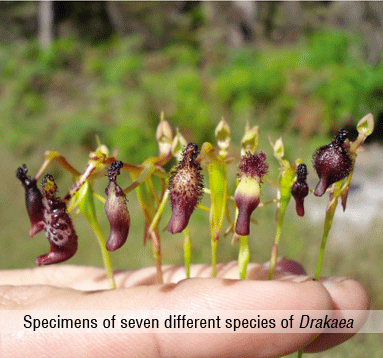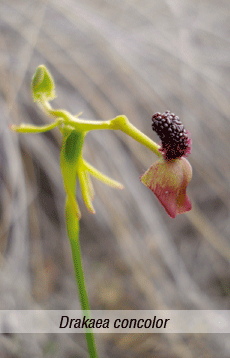<< BACK TO PROJECT LIST
Project: 255/2006
Title: The role of pollinators and mycorrhiza in controlling distribution and speciation in Drakaea – implications for conservation management.
Applicant: Dr. Ryan Phillips, Dr. Andrew Batty, Prof. Kingsley Dixon and Prof. Stephen Hopper
Institute: Botanic Gardens and Parks Authority, West Perth, Western Australia
The genus Drakaea (Orchidaceae) is endemic to south-western Australia and is pollinated by sexual deception of thynnine wasps. Drakaea occupies a specialized habitat of open sandy areas and utilize a unique mycorrhizal fungus. Of the ten species in the genus, five are Declared Rare Flora and another is known only from herbarium records. All species are believed to be highly specific to both pollinator and mycorrhiza.
Baiting for mycorrhiza and pollinators will elucidate the factors controlling distribution and rarity in Drakaea. A combination of population genetics and baiting experiments across the range of Drakaea will provide the mechanisms by which populations diverge ecologically and genetically. Finally, the phylogenies of the Drakaea, wasp and mycorrhiza will be produced to establish how the ecological and genetic processes have shaped co-evolution between the orchid and its hosts. This study represents the first of its type to integrate research of mycorrhiza and pollinators in the study of orchid speciation and conservation and will serve as a benchmark for orchid conservation research.
Papers arising from this research:
Phillips RD, Tingbao X, Hutchinson MF, Dixon KW, and Peakall R. (2013) Convergent specialization – the sharing of pollinators by sympatric genera of sexually deceptive orchids. Journal of Ecology, 101, 826-835.
Phillips RD, Barrett MD, Dixon KW, Hopper SD (2011) Do mycorrhizal symbioses cause rarity in orchids? Journal of Ecology, 99, 858-869.
Phillips RD, Brown AP, Dixon KW, Hopper SD (2011) Orchid biogeography and the factors associated with rarity in a biodiversity hotspot: the Southwest Australian Floristic Region. Journal of Biogeography, 38, 487-501.
Menz MHM, Phillips RD, Winfree R, Kremen C, Aizen MA, Johnson SD, Dixon KW (2011) Reconnecting plants and pollinators: challenges in restoration of pollinator mutualisms. Trends in Plant Science, 16, 4-12.
Anthony JM, Phillips RD, Sinclair EA, Dixon KW (2010) Characterisation of polymorphic microsatellite markers isolated from Drakaea glyptodon Fitz. (Orchidaceae). Conservation Genetic Resources, 2, 291-294.
Phillips RD, Hopper SD, Dixon KW (2010) Pollination ecology and the potential impacts of the environmental change in the Southwest Australian Biodiversity Hotspot. Philosophical Transactions of the Royal Society of London, 365, 517-528.
Phillips RD, Faast R, Bower CC, Brown GR, Peakall R (2009) Implications of pollination by food and sexual deception on pollinator specificity, fruit set, population genetics and conservation of Caladenia. Australian Journal of Botany, 57, 287-306.
Phillips RD, Backhouse G, Brown AP, Hopper SD (2009) Biogeography of Caladenia, with special reference to the Southwest Australian Floristic Region. Australian Journal of Botany, 57, 259-275.
Phillips RD, Peakall R, Hutchinson MF, Linde CC, Tingbao Xu, Dixon KW, Hopper SD (2014) Specialized ecological interactions and plant species rarity: The role of pollinators and mycorrhizal fungi across multiple spatial scales. Biological Conservation, 169 (2014) 285-295
Phillips RD, Brown GR, Dixon KW, Hayes C, Linde CC, Peakall R (2017) Evolutionary relationships among pollinators and repeated pollinator sharing in sexually deceptive orchids. Journal of Evolutional Biology doi:10.1111/jeb.13125

Specimens of seven different species of Drakaea collected for pollinator baiting studies.
From left to right: D. thynniphila, D. livida, D. confluens, D. gracilis, D. elastica, D. micrantha and D. glyptodon.

Drakaea concolor is a rare and endangered species known from a handful of locations in sand-plain from Watheroo to Kalbarri.
It is pollinated by an undescribed species of Zaspilothynnus that is widespread in the region.
